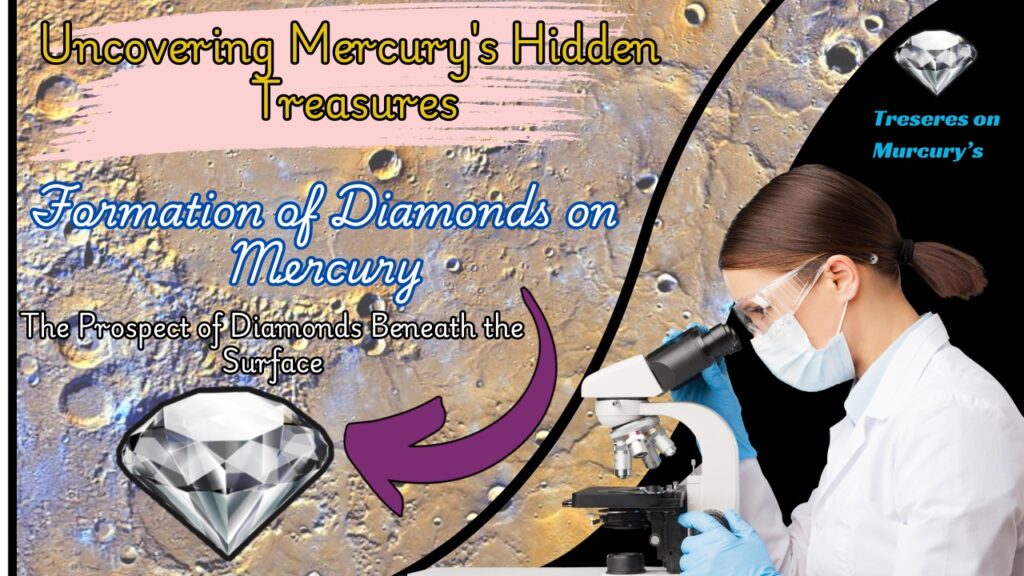Introduction
Mercury, the closest planet to the Sun, has always intrigued scientists with its extreme conditions and unique characteristics. Recent studies have suggested that beneath its scorched surface, Mercury may harbor diamonds formed under intense pressure and heat. This article explores the scientific basis for this hypothesis, the methods used to study Mercury’s subsurface, and the implications of these findings.
Formation of Diamonds on Mercury
Theoretical Basis
Diamonds on Earth are formed deep within the mantle under high pressure and temperature, often brought to the surface by volcanic eruptions. Scientists hypothesize that similar conditions could exist on Mercury due to its unique geological and environmental factors.
- High Temperature: Mercury’s proximity to the Sun results in extreme surface temperatures, which can exceed 800 degrees Fahrenheit (430 degrees Celsius) during the day.
- Pressure: The planet’s dense metallic core and thin crust may create the necessary pressure conditions to form diamonds beneath the surface.
- Carbon Presence: Mercury’s crust is believed to contain graphite, a form of carbon. Under sufficient pressure and temperature, graphite can transform into diamond.
Shock Metamorphism
Another potential mechanism for diamond formation on Mercury is shock metamorphism. This process occurs when meteorites impact the planet’s surface, generating immense pressure and heat that can convert graphite to diamond. Mercury’s heavily cratered surface suggests a history of frequent and significant impacts.
Research Methods
Remote Sensing
Remote sensing technologies, such as those used by the MESSENGER (MErcury Surface, Space ENvironment, Geochemistry, and Ranging) spacecraft, have provided valuable data about Mercury’s composition and surface features. By analyzing spectral data, scientists can infer the presence of specific minerals, including carbon-based compounds that could indicate the presence of diamonds.
Seismology
While direct seismological studies on Mercury are currently not possible due to the lack of deployed instruments, future missions could utilize seismometers to detect and study subsurface structures. Seismic waves could reveal the density and composition of layers beneath the surface, providing clues about diamond formation.
Laboratory Simulations
Laboratory simulations replicate Mercury’s extreme conditions to understand the potential for diamond formation. By subjecting graphite to high pressures and temperatures similar to those on Mercury, scientists can observe the transformation process and confirm theoretical models.
Implications of Diamond Presence
Geological Insights
The presence of diamonds on Mercury would provide significant insights into the planet’s geological history and internal structure. It would suggest that Mercury has experienced the necessary conditions for diamond formation, either through internal processes or external impacts.
Economic Potential
If diamonds are indeed abundant on Mercury, this could have economic implications for future space exploration and mining. However, the technological and logistical challenges of mining on Mercury would be immense, given its harsh environment and distance from Earth.
Comparative Planetology
Studying diamonds on Mercury could also enhance our understanding of diamond formation on other planetary bodies. By comparing conditions on Mercury with those on Earth and other planets, scientists can develop a broader understanding of geological processes across the solar system.
Challenges and Future Research
Technological Limitations
One of the primary challenges in confirming the presence of diamonds on Mercury is the current technological limitation. Remote sensing provides indirect evidence, but direct sampling and in-situ analysis would be required for confirmation.
Future Missions
Future missions to Mercury could include landers equipped with drilling tools and analytical instruments capable of detecting and analyzing diamonds directly. Such missions would provide definitive proof of diamond presence and further our understanding of Mercury’s geology.
Interdisciplinary Research
The study of diamonds on Mercury requires an interdisciplinary approach, combining geology, astronomy, materials science, and engineering. Collaborative efforts among scientists from these fields will be crucial for advancing our knowledge and developing the necessary technologies for future exploration.
Conclusion
The hypothesis that diamonds may be lurking beneath Mercury’s surface opens exciting new avenues for planetary science and exploration. While direct evidence is yet to be obtained, the theoretical basis and indirect data suggest that Mercury’s unique conditions could indeed support diamond formation. Future missions and technological advancements will be essential in confirming this hypothesis and uncovering the secrets of Mercury’s subsurface. As we continue to explore our solar system, the potential discovery of diamonds on Mercury highlights the richness and diversity of planetary processes, offering a glimpse into the complex and dynamic nature of our celestial neighbors.
Future Directions
Advancements in Space Technology
To fully explore the potential diamond reserves on Mercury, advancements in space technology will be crucial. This includes the development of more robust landers, drilling equipment capable of withstanding Mercury’s extreme conditions, and advanced analytical instruments for on-site examination.
International Collaboration
Given the scale and complexity of such missions, international collaboration will be vital. Pooling resources, expertise, and technology from multiple space agencies can enhance the feasibility and success of future Mercury exploration missions.
Education and Public Engagement
Raising public awareness and interest in Mercury exploration can drive funding and support for these missions. Educational programs, public lectures, and media coverage can help demystify the science behind diamond formation on Mercury and highlight its significance.
Ethical Considerations
As the prospect of space mining becomes more tangible, ethical considerations regarding the exploitation of extraterrestrial resources must be addressed. Establishing international guidelines and regulations will ensure that space exploration and mining are conducted responsibly and sustainably.
